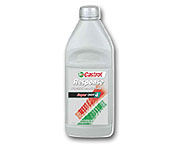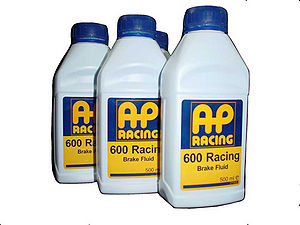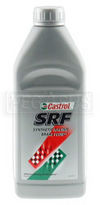Difference between revisions of "Brake fluid"
m |
|||
| Line 3: | Line 3: | ||
Lotus specify Castrol Response Super DOT 4 brake fluid changed annually. This is a fully synthetic brake fluid that exceeds the boiling point specifications of most DOT 5.1 fluids and is no more costly and for road use this is fine. | Lotus specify Castrol Response Super DOT 4 brake fluid changed annually. This is a fully synthetic brake fluid that exceeds the boiling point specifications of most DOT 5.1 fluids and is no more costly and for road use this is fine. | ||
| − | Hard track use with extended high temperatures over 30 minute sessions needs some further consideration; regular change of less expensive fluid or more expensive race fluid changed less ? There is no right answer. | + | Hard track use with extended high temperatures over 30 minute sessions needs some further consideration; regular change of less expensive fluid or more expensive race fluid changed less? There is no right answer. |
The function of brake fluid is to provide an incompressible medium to transmit the driver’s foot pressure to clamp the friction material against the discs. When fresh, all brake fluids are virtually incompressible, but overheated brake fluid will boil in the calliper producing gas bubbles which are compressible leading to a “soft” brake pedal with long travel.<br style="clear:both" /> | The function of brake fluid is to provide an incompressible medium to transmit the driver’s foot pressure to clamp the friction material against the discs. When fresh, all brake fluids are virtually incompressible, but overheated brake fluid will boil in the calliper producing gas bubbles which are compressible leading to a “soft” brake pedal with long travel.<br style="clear:both" /> | ||
| Line 9: | Line 9: | ||
[[Image:AP600 Brake Fluid.jpg|thumb|left|AP600]] | [[Image:AP600 Brake Fluid.jpg|thumb|left|AP600]] | ||
| − | The dry boiling point is the temperature at which a given brake fluid boils when it is fresh out of the can. Since DOT 4, and DOT 5.1 brake fluids are hygroscopic and adsorb water over time (through the breathers, | + | The dry boiling point is the temperature at which a given brake fluid boils when it is fresh out of the can. Since DOT 4, and DOT 5.1 brake fluids are hygroscopic and adsorb water over time (through the breathers, caliper piston seals and by magic) which boils at 100 °C, the absorbed water dramatically lowers the boiling point of the brake fluid. The Wet boiling point is the temperature at which a given brake fluid boils when it has taken on 3.7% H2O. For detailed discussion checkout http://www.stoptech.com/tech_info/wp_brakefluid_1a.shtml<br style="clear:both" /> |
| + | |||
| + | DOT 4 and 5.1 are polyethylene glycol based fluids and are perfectly fine to mix. Don't mix 4 or 5.1 with DOT 5 as it's silicone based and is not compatible. | ||
| + | |||
| + | The specification for DOT 5.1 is higher than DOT 4 - the reality here is that most race fluid is DOT 4 but exceeds the spec of DOT 5.1 in most aspects but may fail the long term tests, hence why they are classified as DOT 4. | ||
| + | |||
Notes from a 40 track hour a year Elise; | Notes from a 40 track hour a year Elise; | ||
| Line 61: | Line 66: | ||
[http://www.aaoil.co.uk/racing-R600 R600+ Found here.] | [http://www.aaoil.co.uk/racing-R600 R600+ Found here.] | ||
| + | |||
| + | [http://en.wikipedia.org/wiki/DOT_5.1 - DOT 5.1] | ||
| + | |||
| + | [http://en.wikipedia.org/wiki/DOT_4 - DOT 4] | ||
| + | |||
| + | [http://en.wikipedia.org/wiki/DOT_5 - DOT 5] | ||
{{clr}} | {{clr}} | ||
Revision as of 13:11, 20 February 2008
Lotus specify Castrol Response Super DOT 4 brake fluid changed annually. This is a fully synthetic brake fluid that exceeds the boiling point specifications of most DOT 5.1 fluids and is no more costly and for road use this is fine.
Hard track use with extended high temperatures over 30 minute sessions needs some further consideration; regular change of less expensive fluid or more expensive race fluid changed less? There is no right answer.
The function of brake fluid is to provide an incompressible medium to transmit the driver’s foot pressure to clamp the friction material against the discs. When fresh, all brake fluids are virtually incompressible, but overheated brake fluid will boil in the calliper producing gas bubbles which are compressible leading to a “soft” brake pedal with long travel.
The dry boiling point is the temperature at which a given brake fluid boils when it is fresh out of the can. Since DOT 4, and DOT 5.1 brake fluids are hygroscopic and adsorb water over time (through the breathers, caliper piston seals and by magic) which boils at 100 °C, the absorbed water dramatically lowers the boiling point of the brake fluid. The Wet boiling point is the temperature at which a given brake fluid boils when it has taken on 3.7% H2O. For detailed discussion checkout http://www.stoptech.com/tech_info/wp_brakefluid_1a.shtml
DOT 4 and 5.1 are polyethylene glycol based fluids and are perfectly fine to mix. Don't mix 4 or 5.1 with DOT 5 as it's silicone based and is not compatible.
The specification for DOT 5.1 is higher than DOT 4 - the reality here is that most race fluid is DOT 4 but exceeds the spec of DOT 5.1 in most aspects but may fail the long term tests, hence why they are classified as DOT 4.
Notes from a 40 track hour a year Elise;
• Comma DOT5.1 £8/lit (Dry 280°C Wet 180°C). Is this as good as the Castrol Super DOT4 ?
• Castrol Response Super DOT 4 £10/lit (Dry 280°C Wet 186°C). This was needing to be changed every 6 track hours with a gradually softening pedal, coming out black from the front callipers and discoloured from the rear.
• Silkolene Pro Race 2000 £18/lit (Dry 300°C Wet 195°C). Need to test this
• AP600 £20/lit (Dry 310°C Wet 210°C). This seems to want 50ml bled off the front callipers every 6 track hours (no noticeable colour change) which will effectively purge the system every year (but don't forget to do the rears and clutch).
• Motul RBF600 £20/lit (Dry 312°C Wet 216°C). To be tested from Opieolis.
• R600+ £24/lit (Dry 315°C Wet 204°C). As used buy Randy.
• Castrol SRF £50/lit (Dry 310°C Wet 270°C) This is in a class by itself with patented chemistry providing wet boiling point close to most other fluids dry. Not affluent enough to try this.
See also: Bleed the brakes


